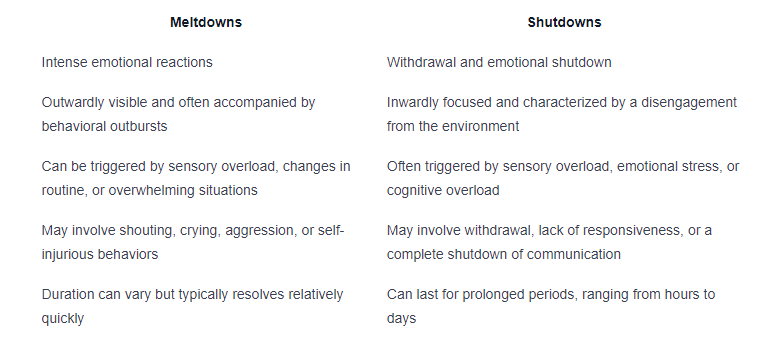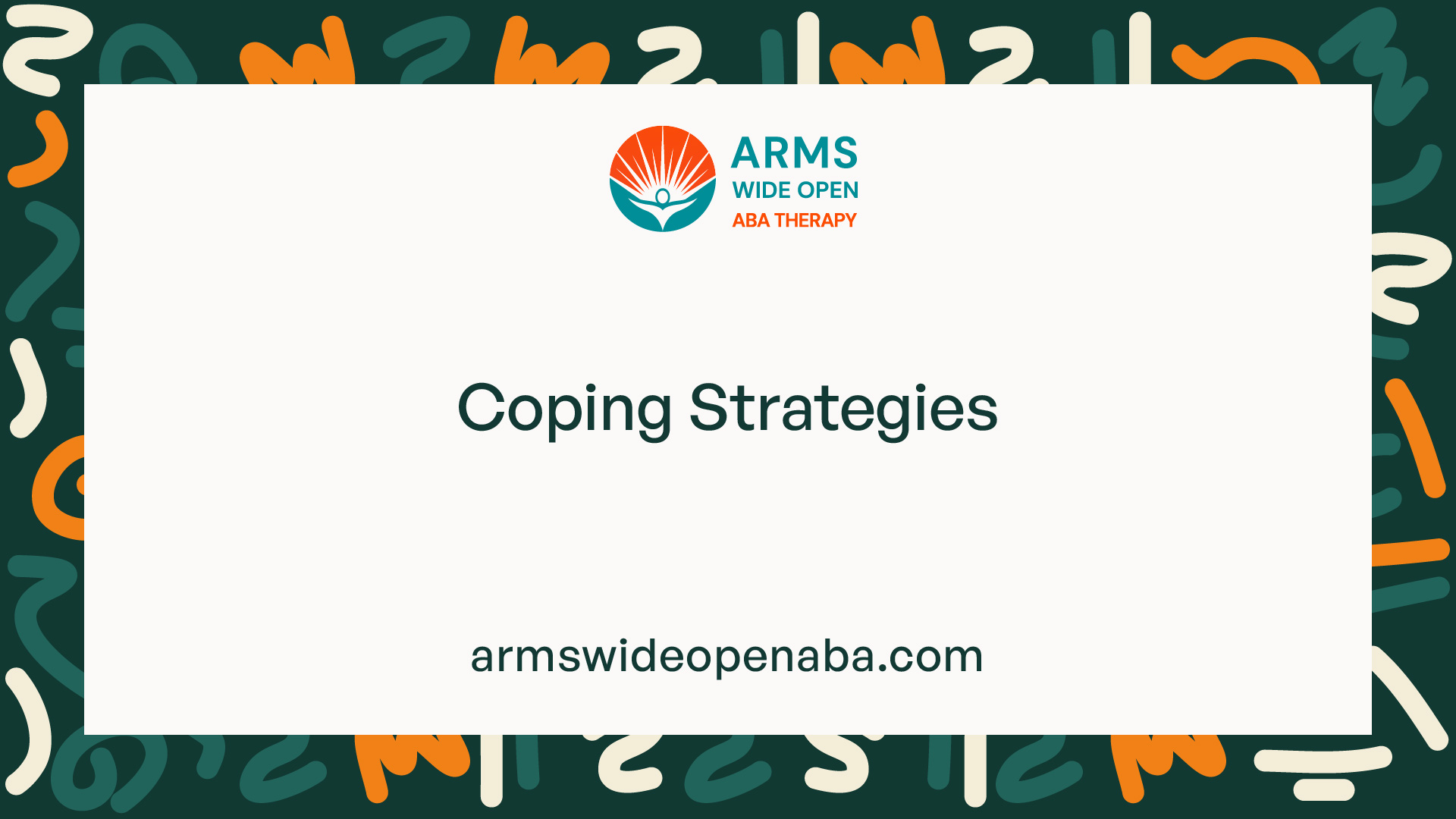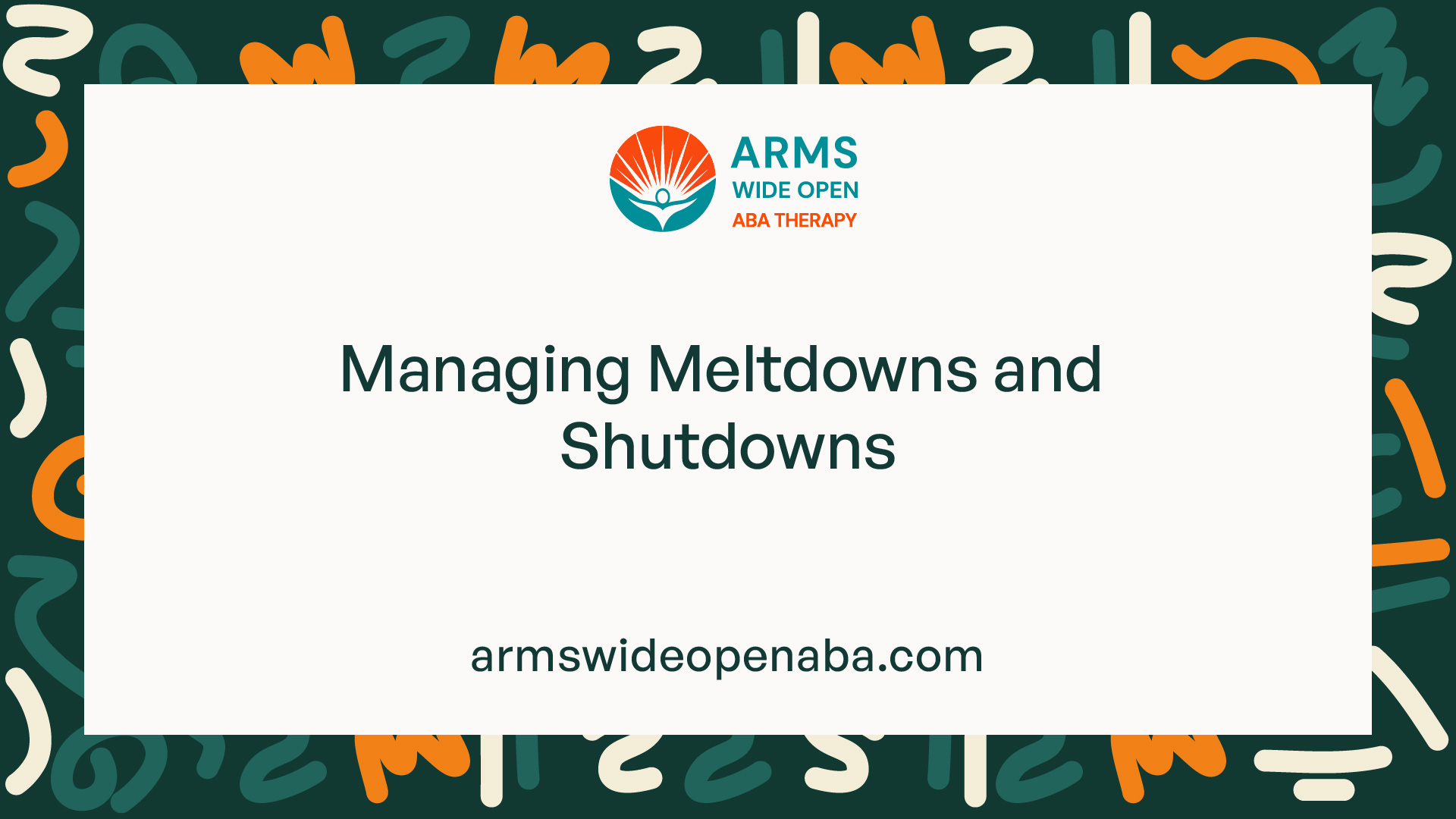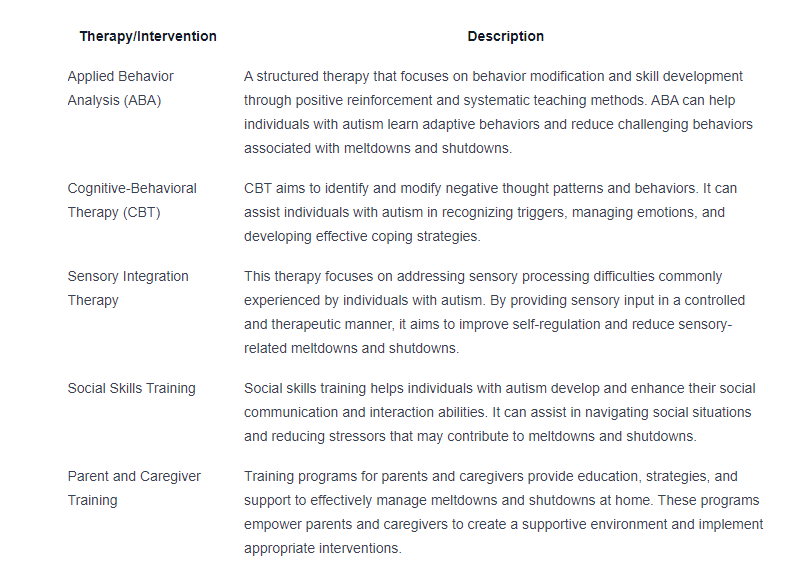Meltdowns and Shutdowns | Autism Space
Unlocking the puzzle of meltdowns and shutdowns in the autism space. Discover coping strategies and support for navigating these challenges.


Understanding Meltdowns and Shutdowns in Autism
In the autism space, meltdowns and shutdowns are common experiences that individuals on the spectrum may encounter. Understanding the difference between meltdowns and shutdowns, as well as identifying their triggers, is crucial in providing appropriate support and intervention.
Differentiating Between Meltdowns and Shutdowns
While meltdowns and shutdowns may appear similar on the surface, there are distinct differences between the two.

Understanding these differences is essential in responding appropriately to individuals experiencing either meltdowns or shutdowns. It is important to note that each individual on the autism spectrum may experience meltdowns and shutdowns differently, so it is crucial to consider their unique needs and experiences.
Triggers for Meltdowns and Shutdowns
Meltdowns and shutdowns can be triggered by various factors, and identifying these triggers is key to minimizing their occurrence and providing appropriate support. Some common triggers include:
- Sensory overload: Overstimulation from bright lights, loud noises, strong smells, or crowded environments can trigger both meltdowns and shutdowns.
- Changes in routine: Sudden changes in schedule, unexpected transitions, or disruptions to familiar routines can cause distress and lead to meltdowns or shutdowns.
- Emotional stress: Feelings of frustration, anxiety, or being overwhelmed by emotions can contribute to meltdowns and shutdowns.
- Cognitive overload: Excessive demands on cognitive processing, such as complex tasks or information overload, can overwhelm individuals on the autism spectrum and trigger meltdowns or shutdowns.
Recognizing and addressing these triggers can help individuals with autism manage and cope with meltdowns and shutdowns more effectively. By creating a supportive and understanding environment and implementing strategies to reduce sensory overload and emotional stress, the impact of meltdowns and shutdowns can be minimized.
Understanding the differences between meltdowns and shutdowns, as well as identifying their triggers, is essential in supporting individuals on the autism spectrum. By providing appropriate interventions and creating a supportive environment, we can help individuals navigate these challenging experiences and promote their overall well-being.
Signs and Symptoms
Understanding the signs and symptoms of meltdowns and shutdowns in individuals with autism is essential for recognizing and managing these challenging experiences. Meltdowns and shutdowns can manifest in various ways, including behavioral, emotional, and physical signs.
Behavioral Signs
Behavioral signs of meltdowns and shutdowns can vary from person to person. Some common behavioral signs include:
- Aggressive or self-injurious behaviors
- Tantrums and outbursts
- Withdrawal or avoidance of social interaction
- Repetitive behaviors, such as rocking or hand-flapping
- Difficulty with transitions or changes in routine
It's important to note that each individual with autism may exhibit different behavioral signs during meltdowns and shutdowns. Understanding the unique behaviors of the individual is crucial for providing appropriate support.
Emotional Signs
Emotional signs can provide insight into the emotional state of an individual experiencing a meltdown or shutdown. These signs may include:
- Intense frustration or anger
- Overwhelm or sensory overload
- Anxiety or fear
- Emotional dysregulation
- Feelings of helplessness or powerlessness
Recognizing the emotional signs can help caregivers and support systems respond empathetically and effectively during these challenging moments.
Physical Signs
Meltdowns and shutdowns can also manifest in various physical signs. These signs may include:
- Increased heart rate
- Rapid breathing or hyperventilation
- Flushed or pale skin
- Clenched fists or tensed muscles
- Increased sensitivity to sensory stimuli
Physical signs can provide valuable cues about the individual's physiological response to stress and can guide the implementation of appropriate coping strategies.
Understanding the behavioral, emotional, and physical signs associated with meltdowns and shutdowns is crucial for providing the necessary support and intervention for individuals with autism. By recognizing these signs, caregivers, educators, and support systems can create a safe and understanding environment that promotes emotional regulation and well-being.

Coping Strategies
When it comes to dealing with meltdowns and shutdowns in the autism space, having effective coping strategies in place can make a significant difference in managing these challenging situations. Here, we will explore strategies specifically designed to help individuals navigate meltdowns and shutdowns.
Strategies for Dealing with Meltdowns
Meltdowns can be overwhelming for both individuals on the autism spectrum and those around them. It's important to approach meltdowns with empathy and understanding. Here are some strategies to consider when dealing with meltdowns:
- Remain Calm: It's crucial to stay calm and composed during a meltdown. Keeping a calm demeanor can help create a sense of stability and security for the individual experiencing the meltdown.
- Provide a Safe Space: Creating a safe and quiet environment can help minimize sensory overload during a meltdown. Find a calm and secluded area where the individual can regain control and feel safe.
- Use Visual Supports: Visual supports, such as visual schedules or social stories, can help individuals with autism understand and anticipate situations that may trigger meltdowns. These visual cues offer a sense of structure and predictability.
- Practice Deep Breathing and Relaxation Techniques: Encouraging deep breathing exercises and relaxation techniques can help individuals regulate their emotions during a meltdown. Techniques like counting to ten or focusing on slow, deep breaths can promote a sense of calm.
Strategies for Dealing with Shutdowns
Shutdowns, characterized by withdrawal and disengagement, require a different set of coping strategies. Here are some strategies that can help individuals navigate shutdowns:
- Respect Personal Space: During a shutdown, it's important to respect an individual's need for personal space and solitude. Give them the time and space they require to recharge and recover.
- Provide Sensory Comfort: Offer sensory comfort items, such as a weighted blanket or fidget toys, to provide a sense of security and help regulate sensory input.
- Offer Supportive Communication: Use clear and concise language to communicate with individuals experiencing a shutdown. Avoid overwhelming them with excessive questions or demands.
- Establish a Structured Routine: Maintaining a structured routine can provide individuals with a sense of predictability and stability, reducing the likelihood of shutdowns. Consistency in daily activities can help individuals feel more in control.
By implementing these coping strategies, individuals on the autism spectrum can better manage meltdowns and shutdowns. It's important to remember that every individual is unique, and what works for one person may not work for another. Tailoring coping strategies to meet the specific needs and preferences of each individual is key in providing effective support.
Support Systems
When it comes to managing meltdowns and shutdowns in the autism space, having a strong support system in place is essential. This section explores two key aspects of support: building a support network and educating others about meltdowns and shutdowns.
Building a Support Network
Building a support network is crucial for individuals with autism who experience meltdowns and shutdowns. This network can consist of family members, friends, educators, therapists, and other professionals who understand and empathize with the challenges faced by individuals on the autism spectrum.
A support network provides both emotional and practical support. It offers a safe space for individuals to share their experiences and concerns, as well as seek advice and guidance. The members of the support network can offer understanding, patience, and assistance during difficult times.
It's important to involve individuals who are willing to learn about autism and its associated challenges. They can provide validation, empathy, and reassurance. By building a diverse support network, individuals with autism can feel more understood, accepted, and supported.
Educating Others About Meltdowns and Shutdowns
Education about meltdowns and shutdowns is vital in creating a supportive environment for individuals with autism. By educating others, we can raise awareness and promote understanding of these experiences. This knowledge enables others to respond appropriately and offer the necessary support during meltdowns and shutdowns.
Educating others involves providing information about the signs, triggers, and coping strategies related to meltdowns and shutdowns. It helps dispel misconceptions and reduce stigma surrounding these behaviors. By increasing awareness, we can foster a more inclusive society that embraces neurodiversity.
Key Points to Educate Others
Meltdowns and shutdowns are common experiences for individuals with autism.
Meltdowns are intense reactions to overwhelming situations, while shutdowns involve withdrawal and reduced responsiveness.
Triggers for meltdowns and shutdowns can vary from person to person.
It's important to create a supportive and understanding environment during meltdowns and shutdowns.
Strategies such as providing a calm space and offering sensory support can help during these episodes.
By educating others about meltdowns and shutdowns, we can cultivate a community that not only accepts but also actively supports individuals on the autism spectrum. This understanding strengthens the support system and promotes a more compassionate and inclusive society.

Managing Meltdowns and Shutdowns
When it comes to managing meltdowns and shutdowns in individuals with autism, creating a safe environment and implementing sensory support strategies are essential. These approaches can help to prevent meltdowns and minimize the impact of shutdowns.
Creating a Safe Environment
Creating a safe environment is crucial for individuals with autism to feel secure and comfortable. Here are some strategies to consider:
- Establish a predictable routine: Maintaining a consistent daily routine provides a sense of structure and stability, which can help reduce anxiety and prevent meltdowns.
- Provide clear communication: Use visual supports, such as schedules, social stories, and visual cues, to enhance understanding and minimize confusion.
- Ensure a calm and quiet space: Designate a quiet area where the individual can retreat to when feeling overwhelmed or experiencing sensory overload.
- Minimize sensory triggers: Identify and reduce sensory triggers in the environment, such as loud noises, bright lights, or strong smells. Use noise-canceling headphones, dim lighting, and scent-free products, if necessary.
- Encourage self-regulation: Teach and support the development of self-regulation techniques, such as deep breathing exercises, mindfulness, or sensory breaks.
Implementing Sensory Support
Sensory support strategies can be highly effective in managing meltdowns and preventing shutdowns. These strategies aim to address sensory sensitivities and provide a supportive sensory environment. Consider the following approaches:
- Sensory diets: Develop a personalized sensory diet in collaboration with an occupational therapist. This may include activities that provide sensory input, such as swinging, brushing, or weighted blankets, to help regulate sensory systems.
- Sensory-friendly spaces: Designate specific areas or zones that cater to different sensory needs, such as a quiet area, a tactile exploration corner, or a sensory integration room.
- Sensory tools and aids: Provide sensory tools and aids, such as fidget toys, stress balls, or chewable jewelry, to help individuals with autism self-regulate and manage sensory input.
- Visual supports: Use visual supports, such as visual schedules, visual timers, or choice boards, to enhance communication and reduce anxiety.
By creating a safe environment and implementing sensory support strategies, individuals with autism can better manage meltdowns and navigate through shutdowns. It's important to tailor these approaches to the specific needs and preferences of each individual. Consulting with professionals, such as occupational therapists or behavior analysts, can provide further guidance in developing effective management strategies.
Seeking Professional Help
When it comes to managing meltdowns and shutdowns in the autism space, seeking professional guidance can be beneficial for individuals and their families. Professional assistance provides valuable insights, strategies, and interventions to help navigate these challenging situations.
When to Seek Professional Guidance
It is important to recognize when it is appropriate to seek professional help for meltdowns and shutdowns in the context of autism. Here are some indicators that may suggest the need for professional guidance:
Indicators
Frequent and severe meltdowns or shutdowns that significantly impact daily functioning
Challenges in identifying triggers or understanding the underlying causes
Difficulty implementing effective coping strategies
Emotional and behavioral difficulties that persist over time
Struggles in maintaining relationships and engaging in social interactions
If you or your loved one with autism experience any of these indicators, it may be beneficial to consult with professionals who specialize in autism and behavior management.
Therapy and Interventions for Meltdowns and Shutdowns
There are various therapies and interventions available to support individuals with autism in managing meltdowns and shutdowns. These interventions are tailored to the specific needs and strengths of each individual. Here are some common therapies and interventions utilized in the autism space:

It is important to consult with professionals experienced in working with individuals on the autism spectrum to determine the most suitable therapy or intervention based on individual needs.
Seeking professional help can offer valuable guidance and support for individuals with autism and their families in managing meltdowns and shutdowns. Through therapy and interventions tailored to the specific needs of each individual, professionals can assist in developing effective coping strategies and improving overall well-being. Remember, professional guidance should always be sought in conjunction with a comprehensive care plan that includes support from family, friends, and other community resources.
Sources
https://www.leicspart.nhs.uk/autism-space/health-and-lifestyle/meltdowns-and-shutdowns/
https://www.ambitiousaboutautism.org.uk/understanding-autism/behaviour/meltdowns-and-shutdowns
https://autismwestmidlands.org.uk/wp-content/uploads/2019/12/Meltdown_and_Shutdown_Nov_2019.pdf
Similar articles
We’re here to help you

Our team is here to assist you in this process. Contact us for any assistance.
it’s easy to apply
We Accept Most Insurances
Our in-network insurance partnerships make ABA therapy more accessible to families throughout our service areas.







Our Insurance Process
We'll request your insurance details to help us verify your plan's coverage for ABA therapy. Once we've received this information, we'll walk you through your benefits, including copayments, deductibles and out-of-pocket maximums, so you know what to expect in advance.
Our team will then handle the preauthorization and all the necessary paperwork.
.svg)





















.jpeg)


































.jpeg)




.jpeg)







.jpeg)











.jpeg)
















